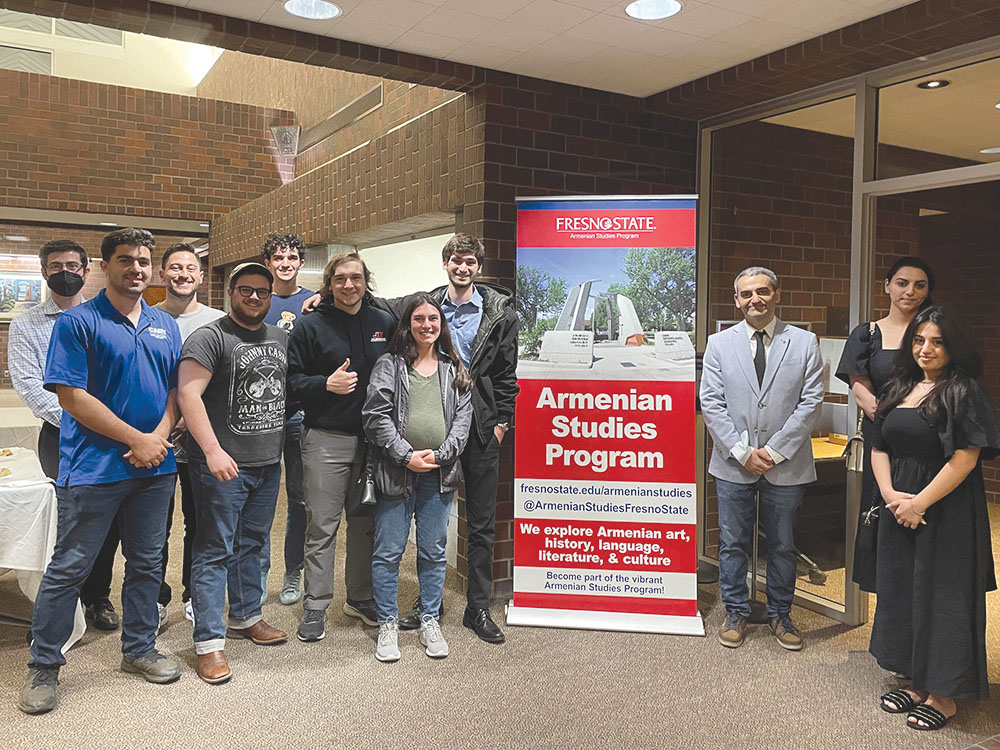
Photo: Andrew Hagopian
Sosse Baloian
Staff Writer
The topic of genocide has become more “intercultural,” stated Dr. Suren Manukyan. “Forty years after the appearance of the field of genocide studies, we can appreciate how far it has reached from the interest of a small group of individuals to an academic domain with hundreds of scholars, thousands of students, and one of the most attractive and dynamically developing social disciplines.”
On Tuesday, March 8, 2022, the Armenian Studies Program welcomed Dr. Manukyan to lecture on the topic of “New Trends in Genocide Studies.” This was the first in-person lecture the Armenian Studies Program hosted since the onset of the COVID-19 pandemic in March 2020.
Dr. Manukyan was the Kazan Visiting Professor in Armenian Studies at Fresno State for the Fall 2021 semester. He is the Head of the UNESCO Chair on Prevention of Genocide and Other Atrocity Crimes at Yerevan State University and Head of the Department of Comparative Genocide Studies at the Armenian Genocide Museum-Institute (Yerevan). He is also a visiting lecturer at the American University of Armenia and he has been a Fulbright Scholar at the Center for the Study of Genocide and Human Rights at the Rutgers University of New Jersey.
Dr. Manukyan introduced Raphael Lemkin as the founder of the field of genocide studies. Lemkin coined the term “genocide,” wrote several papers about the topic, and inspired future genocide scholars. Although the Genocide Convention was adopted by the United Nations in 1948, Dr. Manukyan said that it was not enforced for many years due to the Cold War. “It would have been almost impossible for the international community to investigate the crimes and take action if the massacres happened in the state under [the influence of either the Soviet Union or the United States of America].”
The first scholars of genocide studies focused on such topics as definitions of genocide, causes of genocide, comparative case studies of genocide, and models for prevention. “Genocide studies has come a long way over the past decade having obtained a level of intellectual sobriety, academic credibility, and public recognition,” remarked Dr. Manukyan. “New scholars have brought about new developments in the field such as a shift from macro-histories to micro-histories, colonial genocides, prevention, activism, and a shift of focus from perpetrators to victims.”
Over the years, micro-histories, local studies of genocide, have gained significant attention in comparison to macro-histories, the basis of genocide studies. Dr. Manukyan said this shift offers a richer understanding of violence on a micro level. Micro-histories of genocide can be studies of communities affected by genocide and studies on perpetrators as individuals. Some examples Dr. Manukyan mentioned were The Armenians of Aintab: The Economics of Genocide in an Ottoman Province written by Ümit Kurt and Talaat Pasha: Father of Modern Turkey, Architect of Genocide written by Hans-Lukas Kieser.
Another trend is the emerging topic of colonial genocides. “Although genocide research is conducted worldwide, the field is still dominated by Eurocentric attitudes and approaches,” stated Dr. Manukyan. “Genocide is commonly understood as a phenomenon that can only occur in either totalitarian or failing states in the so called third-world. According to this assumption, the best way to prevent mass violence would be the global spread of Western style liberalism, capitalism, and democracy.” However, scholars have recently turned toward the idea of Western democracies as also perpetrators capable of genocide.
The development of genocide prevention has ignited interesting discussions as to how we must act in order to stop genocide from happening. Dr. Manukyan introduced an interesting concept of genocide scientists as doctors who are responsible for the healing, treating, and prevention of genocide. He said that genocide scholars and the United Nations have stressed the need for early warning systems. Some have suggested that journalists’ reports could serve as early warning signals while others argue that journalists are not trained to decipher potential early warning signals nor are they in the business of doing so.
Surprisingly, one of the most debated topics amongst genocide scholars is activism. Some have argued that genocide scholars should not partake in activism because it calls the validity of their scholarship into question. “One has to wonder how an individual can work in the field of genocide studies and not be concerned with preventing genocide,” Dr. Manukyan declared. “Lemkin himself never acted as a pure academician. It was an example of successful activism that brought about the adoption of the Genocide Convention.”
The shift of focus from perpetrators to victims is another recent development in the field of genocide studies. Dr. Manukyan clarified that victim testimonies should not overshadow the role of perpetrators, but should be integrated in order to better understand the scope of the genocide.
Dr. Manukyan reminded the audience that genocide is never just about killing people, but about seizing property, destroying culture, denying memories, and silencing the victims.
The field of genocide studies has grown since its introduction in the twentieth century and works are being published in several different languages.
“New research tools are being introduced, new topics are being raised, and all the research is being redrafted,” stated Dr. Manukyan. “Genocide studies has turned into a global field having gained an institutional foothold on all continents.”
 Hye Sharzhoom Armenian Action
Hye Sharzhoom Armenian Action